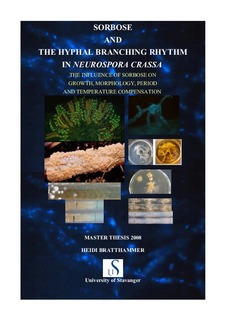| dc.contributor.author | Bratthammer, Heidi | |
| dc.date.accessioned | 2009-01-29T11:40:07Z | |
| dc.date.issued | 2008 | |
| dc.identifier.uri | http://hdl.handle.net/11250/182402 | |
| dc.description | Master's thesis in Biological chemistry | en |
| dc.description.abstract | The glucose analogue sorbose has an interesting effect on the growth of the fungus
Neurospora crassa. On sorbose Neurospora crassa wild type (wt) grows slower and with a
marked difference in morphology. The appearance of a noncircadian hyphal branching
rhythm with a lack of temperature compensation is a known effect of sorbose grown wt
Neurospora crassa.
The aim of this study was to determine if previous results reported by Feldman on the
phenomenon of the hyphal branching rhythm and its lack of temperature compensation, were
reproducible. The hyphal branching rhythm is a specific rhythm which appears when wt
Neurospora crassa goes into hypherbranching morphology. This results in seemingly timed
“wave fronts” where the hyphal branching is most pronounced.
The hyphal branching rhythm is in sharp contrast to the free running, circadian and
temperature compensated conidiation rhythm of Neurospora crassa in constant dark
conditions (DD) and a constant temperature range between 18°C and 32°C. Neurospora
crassa `s conidiation rhythm is the timed and rhythmic execution of spore formation which is
visually observable and can be seen as a rhythmic formation of orange hives of spores in a
glass tube. The conidiation rhythm disappears in constant light conditions (LL). The rhythm is
governed by an internal genetic /transcriptional biological clock or oscillator where the key
element is the gene frequency (frq) and its product, the protein FREQUENCY (FRQ).
In 1974 Feldman reported that the period of a wt Neurospora crassa strain grown on
sorbose/sucrose media was poorly temperature compensated and not influenced by LL
conditions. Feldman found that the period length of the hyphal branching rhythm increased
from 21.1 h to 93.1 h over a range of constant temperatures from 30°C to 20°C. The control
media without sorbose produced a steady conidiation rhythm with circadian properties.
The results from this thesis confirm Feldman’s results that the hyphal branching rhythm is
poorly temperature compensated and that the period length of the hyphal branching rhythm
increase with decreasing constant temperature. Contributing to the hyphal branching rhythm
are morphological changes, such as tight colonial growth, extensive hyphal branching, few
aerial hyphae and sporadic conidiation. The hyphae of Neurospora crassa grown on sorbose
vi
are shorter, thicker and more deformed than hyphae from wt Neurospora crassa growing on
media without sorbose. This is thought to be the results of alteration in cell wall composition,
mainly the depletion of β -1,3 -glucan in the cell wall.
The question whether the hyphal branching rhythm is a biological rhythm controlled by a
circadian rhythm like that which is controlling the conidiation rhythm has been examined by
using the knock out mutant frq 10 in DD conditions at 29°C. On minimal media without
sorbose frq 10 grew fast, and with normal mycelial spreading, but without rhythmic conidial
bands. Grown on sorbose, frq 10 showed the hyphal branching rhythm as the wt Neurospora
crassa. It therefore appears that the hyphal branching rhythm is independent of the frq gene
and its products. | en |
| dc.format.extent | 8630529 bytes | |
| dc.format.mimetype | application/pdf | |
| dc.language.iso | eng | en |
| dc.publisher | University of Stavanger, Norway | en |
| dc.relation.ispartofseries | Masteroppgave/UIS-TN-IMN/2008 | en |
| dc.subject | biologisk kjemi | |
| dc.title | Sorbose and the Hyphal branching rhythm in neurospora crassa : the influence of sorbose on growth, morphology, period and temperature compensation | en |
| dc.type | Master thesis | en |
| dc.subject.nsi | VDP::Mathematics and natural science: 400::Basic biosciences: 470::Biochemistry: 476 | en |
